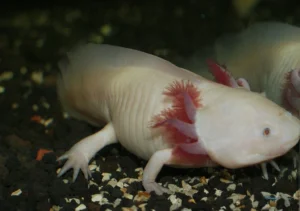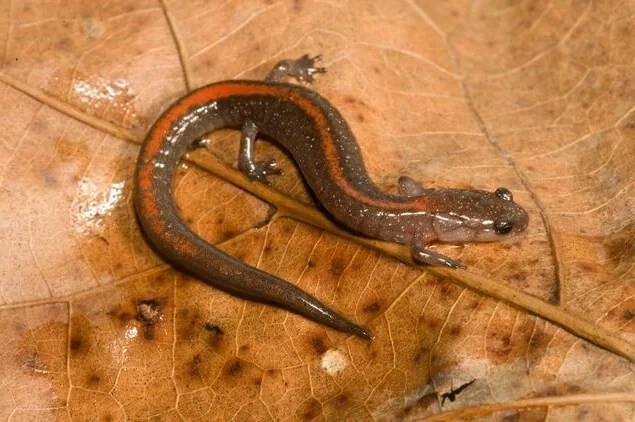Salamanders are some of the most unusual animals on Earth. These small, slippery creatures belong to a group called amphibians, just like frogs and toads. But salamanders are different in many ways.
Salamanders can breathe in four different ways: with lungs, with gills, through their skin, and even through the lining of their mouth and throat. Some salamanders use only one of these methods, while others use two or more at the same time. Many can breathe through their skin, which is why they always need to stay moist to survive.
How Most Animals Breathe
Most animals breathe using lungs. We take air into our bodies, our lungs pull out the oxygen, and we breathe out carbon dioxide.
Fish are different, they use gills to pull oxygen out of water.
But salamanders aren’t like most animals. They’ve found several clever ways to get the oxygen they need. Some use lungs.
Some use gills. Some use their mouths. And many rely on their skin.
Four Ways Salamanders Can Breathe
Salamanders don’t all breathe the same way. Some use one method. Others use two or more. Let’s look at the four ways they can breathe.
1. Lungs
Some salamanders have lungs, just like humans. These lungs help them breathe when they’re on land. They take in air and pass oxygen into the blood.
Then the blood carries the oxygen to the rest of the body. Many land-dwelling salamanders use lungs most of the time.
2. Gills
Other salamanders have gills. These work like the gills of a fish. They pull oxygen straight out of the water.
Gills usually look like little feathers that stick out from the sides of the head.
Some salamanders have gills only as babies. Others, like axolotls and mudpuppies, keep them for life.
3. Skin
Here’s where salamanders truly stand out. They can breathe through their skin. This is called cutaneous respiration.
Their skin lets oxygen pass in and carbon dioxide pass out. It works best when their skin is moist. That’s why salamanders always need to stay damp.
4. Mouth and Throat
Some salamanders can also absorb oxygen through the soft, moist parts of their mouth and throat. It’s not their main method of breathing, but it helps when they need extra oxygen.
Can They Really Breathe Through Their Skin?
Yes, they absolutely can. It might sound strange, but for many salamanders, skin breathing is a major part of how they stay alive.
Their skin acts like a giant lung, pulling in oxygen and pushing out carbon dioxide.

This only works if the skin stays moist. If it dries out, they can’t breathe properly. That’s why salamanders spend so much time in damp places, under logs, near streams, or in wet forests.
Skin breathing only works if the skin is wet. Dry skin can’t pull in oxygen.
That’s why salamanders have a natural slime on their skin. It keeps them moist. If their skin dries out, they can’t breathe, and they may die.
That’s also why they hide during the day and come out at night or after rain. They’re avoiding the sun and staying cool and damp. It’s not just comfort, it’s survival.
How Their Skin Helps Them Breathe
Salamander skin is very thin. Underneath that thin skin are tiny blood vessels called capillaries. These are close to the surface.
Oxygen from the air or water passes through the skin and goes straight into the blood. At the same time, carbon dioxide leaves the blood and escapes through the skin.
Because their skin is soft, thin, and wide compared to their body size, it gives them a large surface to breathe through.
The more damp skin exposed, the more air they can take in.
Different Salamanders Use Different Breathing Methods
Not every salamander breathes the same way. Some live in water. Others live on land. Some have lungs, while others don’t. Each type has its own breathing method that fits the way it lives.
Salamanders That Live in Water
Salamanders like axolotls and mudpuppies spend their whole lives in water. They often keep their gills even when they’re adults.

These feathery gills let them pull oxygen straight from the water.
But that’s not their only method. Many also use their skin to breathe. Some even have lungs, though they may not use them very much. This mix of methods helps them survive in different water conditions.
Salamanders That Live on Land
Land-dwelling salamanders, like the tiger salamander, usually have lungs. These let them breathe air just like we do.
But they still use their skin too. Their skin helps them take in extra oxygen, especially when they’re moving a lot or resting in damp places.
You can often find these salamanders under leaves or logs in the woods. They like dark, moist places where their skin stays wet and breathing is easier.
Salamanders With No Lungs at All
Some salamanders (such as red salamanders)don’t have lungs or gills. They rely only on their skin and the soft tissue in their mouths. These belong to a group called the lungless salamanders, or Plethodontidae.
Even though they have no lungs, they survive just fine. Their small size and thin skin help them get enough oxygen this way. But they always need to live in damp environments to keep breathing.
Evolution and Breathing
Salamanders have been around for millions of years. Over time, they’ve adapted to different environments by changing how they breathe.
In wet places, skin breathing works well. In dry places, lungs are more helpful. In water, gills are better.
Each type of salamander has found a breathing system that works best for where it lives. It’s a good example of how nature finds different ways to solve the same problem.
Things That Affect Salamander Breathing
A few key things in the environment can make breathing easier (or harder) for salamanders.
Moisture
Moisture is the most important. If the air or ground is too dry, their skin can’t work properly. Salamanders need to live in humid places. That’s why they stay near streams, under leaves, or deep in the soil.
Temperature
Temperature matters too. When it’s too hot, their skin dries out. When it’s too cold, their body slows down, including how they breathe.
Mild, moist weather is ideal for most salamanders.
Pollution
Polluted air or water can harm salamanders quickly. Chemicals can damage their thin skin, making it hard for them to breathe.
Polluted water can also lower oxygen levels, making gill breathing harder. This is why salamanders often disappear first when an area gets polluted.
Habitat Loss
When forests are cut down or wetlands are drained, salamanders lose their safe, moist homes. Without those places, they dry out, overheat, or starve. Even small changes in their environment can hurt them badly.
Why Salamanders Are Important
Salamanders play an important role in nature. They eat insects and other small animals, helping keep bug numbers under control. They’re also food for birds, snakes, and fish.
Because they breathe through their skin, they’re very sensitive to changes in their environment. Scientists use salamanders to check how healthy an area is. If salamanders are thriving, it’s usually a good sign.
How We Can Help
Because salamanders are so sensitive, even small actions can help protect them. We can help by keeping water clean and avoiding chemicals that run off into streams and soil. We can also protect forests, ponds, and wetlands, places where salamanders live and breathe.
Supporting conservation groups and learning more about these animals also helps. The more we know, the more we can do to keep their world safe.
Conclusion
Salamanders have some of the most fascinating ways of breathing in the animal kingdom. Some use lungs. Some use gills.
Some use only their skin. And some use a mix of all three. These different methods have helped salamanders survive in forests, streams, caves, and even underground.
Hi, my name is Ezra Mushala, i have been interested animals all my life. I am the main author and editor here at snakeinformer.com.

